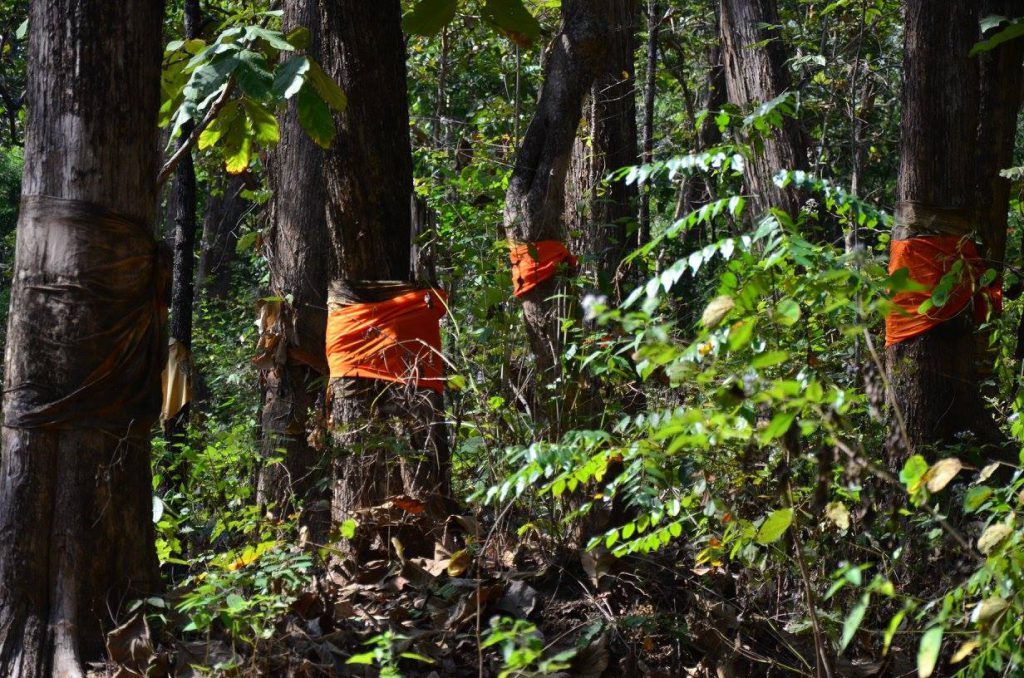Last December, young community leaders from the Mekong states and a delegation from the Bertha Foundation network were invited by EarthRights International on a 4-day field trip in northern Thailand. We were hosted by villagers who have for decades peacefully resisted the construction of a dam that would have them expelled from their ancestral land.

Before we entered the golden teak forest, we had to make a stop, just at the very entrance. We waited in our pick-up trucks and observed Paw Saman, the spirit medium walk up to the spirit house. The monk accompanying us was also waiting. Inside the spirit house, a small and open wooden hut, Paw was moving objects – some dry flower necklaces, I couldn’t quite see – but he seemed concentrated. He was speaking quietly; explaining to the spirit of the forest who we were, why we were here, and promised we wouldn’t hurt any of its living beings during our visit. Once that was done, we were allowed to enter the thick forest, which felt very special, for we were led into the largest golden teak forest left in Asia.
Right then I thought that if that forest indeed does have a spirit, then it most certainly is grateful to the Sa-iab community, which the spirit medium belongs to. For if it wasn’t for these villagers’ resistance against the Thai government and the World Bank, the forest and its extraordinarily rare ecosystem would have disappeared off the face of the earth a couple of decades ago. To be replaced by a big artificial pool of water held up against a 90 meter high dam wall.
The forest is part of the Mae Yom national park in the Phrae province of northern Thailand. Since 1989, it has been at the heart of a battle about the construction of the Kaeng Sua Ten Dam (the “jumping tiger” dam) on the Yom River. The dam would mean the expulsion of at least 3,500 families from their ancestral land.

Originally conceived to generate electricity, then to help the irrigation system and today to control floods, the dam project fails to convince anyone looking closely at its costs versus benefits. Yet, Thai politicians and industries are doing all their might for it to happen. “Why?” we asked. “Well, the golden teak trees would be cut down before the dam is built and anyone getting them will be a millionaire”, explained Paw Saeng Kwanyeun, the “first generation” campaign leader.
Large dams “will have disastrous environmental and socio-economic consequences” was the conclusion recently drawn by the world’s leading authority on the impact of dams, 85 year-old anthropology professor Thayder Scudder (California Institute of Technology), although he himself, back in the days, supported the construction of dams. A 2014 Oxford university study on 245 large dams built between 1934 and 2007 finds them utterly cost-ineffective, regardless of the almost always negative social and environmental impacts.
Yet, the construction of dams is displacing an estimated 2 million people a year. But in this one case, people actually succeeded for 26 years in preventing it. The story of these villagers’ resistance is so fascinating that our partners from EarthRights International (ERI), itself founded by a Burmese activist and an US lawyer, brought a delegation of us from the Bertha Foundation network and young earth rights defenders studying at ERI’s Mekong School to them.

Curious about what the Thai government’s promise of resettlement would look like, in the early 90’s the Sa-iab villagers visited a number of other communities who had been resettled in similar scenarios. They saw only poverty, nonsense farming attempts in unfertile lands, and an aging isolated population with the younger generations having to become migrant workers in Bangkok. As they decided to oppose the project, they faced years of tricks, lies and even spying by dam proponents. In response, they started installing checkpoints, preventing pro-dam people’s access on their land, conducted heavy protesting, and organized their campaign at the national level with other environmentalist defenders of the “Assembly of the Poor”. After a heated opposition to a visiting delegation of the World Bank, public services were even cut off from the community, which then started functioning in a hermit kind of way. Relentlessly, united in their spiritual beliefs – they never start a protest without first asking for the spirit’s blessing and regularly sacrifice animals for it – they also appealed to conservationists of Thailand, and got the project to be delayed, scaled down and ultimately cancelled. Incredibly, though, a scaled-back version of it consisting of two smaller dams, called “the Upper and Lower Yom Dam”, is now on the government’s agenda.

Once inside the forest, we saw dozens of golden teak trees wrapped in more or less faded orange Buddhist-style robes. That’s what we were here for: a tree blessing. One was chosen because it was wonderfully straight and tall of 120 meters. The Buddhist monk sang a long, charismatic song before the robe was wrapped around the tree. “Now that it is blessed, cutting it down would amount to killing a monk”. The day after, it was the river which was blessed.
But it is in the village, where “No Dam No War” signs are painted on houses, that the spirit medium told us what struck me the most: in their decades-long efforts to oppose the dam, they have conducted the cursing of pro-dam politicians. An effigy of them, with their picture on the doll’s face, will be burned, stabbed, sling-shot in the eyes and a fake funeral ceremony will ensue. “How successful do you think these cursing ceremonies are?” I asked. “Very. Out of the ten politicians we cursed, five of them died.”

Some of the Buddhists amongst us were shocked: this is contrary to teachings on non-violence and karma. Others were explaining their communities do just the same with gold mine constructors. Can these cursing ceremonies be deemed violent? “This is self defense” said one the villagers. “Someone is holding a knife at our throats. We don’t have nuclear power but we have local wisdom power, power of the people, and we will use our own tactics to win.” How do these tactics compare to the violence of expelling thousands from their ancestral farming land and the destruction of an entire ecosystem?
There is no need for some orientalist Avatar imagination of another planet’s struggle and no need for a white savior. This small community’s organized resistance keeps defeating a government. That leaves us with one thing to do: learn.
 Claire Tixeire, Director of Education Program, European Center for Constitutional and Human Rights
Claire Tixeire, Director of Education Program, European Center for Constitutional and Human Rights
Follow ECCHR on Twitter @ECCHRBerlin
Article Tags: Bertha Fellows / ECCHR / environmental protection / ERI / human rights lawyers / Land Rights / movement lawyering